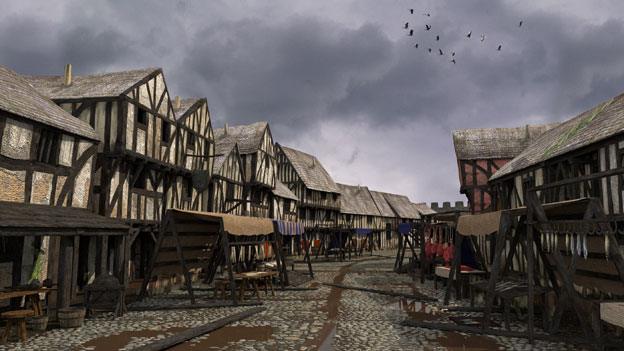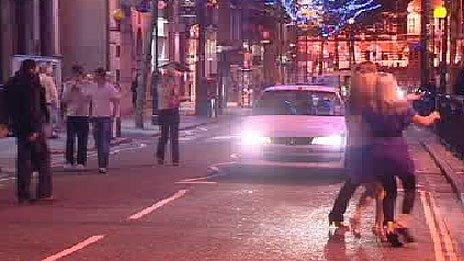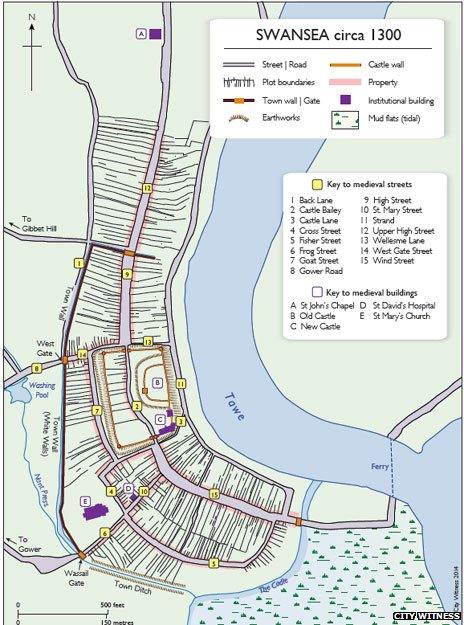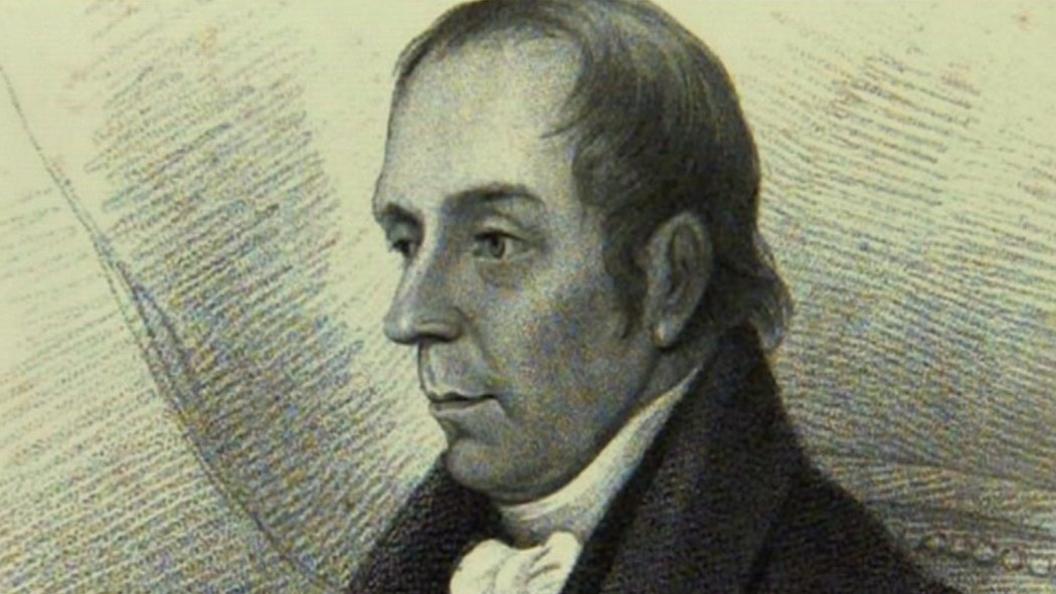Swansea's Wind Street - medieval style
- Published

Wind Street - re-imagined as it was in 1300
It's Saturday, it's Wind Street in Swansea city centre but it's the 14th Century and there isn't a hen party or an empty burger carton in sight.
This is how medieval Swansea probably looked in the year 1300. They don't close it off to traffic for nightclub-goers but for market stalls.

Marking the spot of medieval locations
If you want to walk in the footsteps of your forebears 700 years ago, there is now a series of markers around Swansea which will link to interactive digital reproductions of what life was like on smartphones.
Forget the police station, there's the dungeon at Swansea Castle.
And for those really misbehaving, there are always the gallows. Near the railway station you can find a marker on High Street where people watched criminals and outlaws being executed on the hilltop by the Anglo Norman lord.
Where the Cross Keys pub stands was the site of the former St David's Hospital. Founded in 1332, the hospital once housed elderly and infirm clergy and laymen.
Other pavement markers include the medieval location of the former town wall close to the Quadrant shopping centre.
The 17 markers are part of the City Witness project, external which has also produced new maps of medieval Swansea and computer-generated visualisations of the medieval town.

THE HANGED MAN - 'RESTORED TO LIFE'

William Cragh - alive and digitised
There is the strange story of William Cragh or William The Scabby, a rebel who had been hanged in Swansea in 1290 but then - apparently - miraculously was restored to life.
His story emerges in a manuscript in the Vatican, during evidence of miracles being gathered for the canonisation of a saint in 1307.
The gallows broke during the first attempted hanging. But then after the second apparently succeeded - the dead body is described in graphic detail - the wife of the Lord of Gower William de Briouze says prayers over the corpse and it shows signs of life.
Witnesses from Swansea describe the scene. They include a priest, a labourer, a 13-year-old boy and Cragh himself - who recalls strange visions in the castle dungeons before the hanging.
"We knew about the story but the fact it was set in Swansea will be a surprise to people," said Prof Catherine Clarke, formerly of Swansea University but now at Southampton. "The level of detail it gives of Swansea and some of the ordinary people living there at the time is fantastic."


Wind Street - the layout is much the same today
Swansea was a walled, fortified town, with gates, and an important port - a bastion of power for the Anglo Norman lord.
Prof Catherine Clarke said: "Wind Street was wider than it is now but the layout hasn't changed that much at all.
"There was a market there, and the town was known for its leather trade. I'm sure there was some merriment too although a little different to what we see today!"
She said the big differences from medieval times were the re-routing of the River Tawe in the 19th Century and the old medieval street layout disappearing after the Blitz in 1941.
With GPS technology, people will be able to walk the streets and toggle between modern and medieval maps of Swansea.
The Vatican manuscript telling William Cragh's story is also online, external, with links to photos and stories at various points as people take their own walking tours.
City Witness was launched on Friday night at Swansea Museum, and workshops and a medieval tour is being held on Saturday.
An exhibition will also run at Swansea Museum until 7 September.

The 14th Century layout of Swansea
- Published12 April 2014

- Published10 September 2010